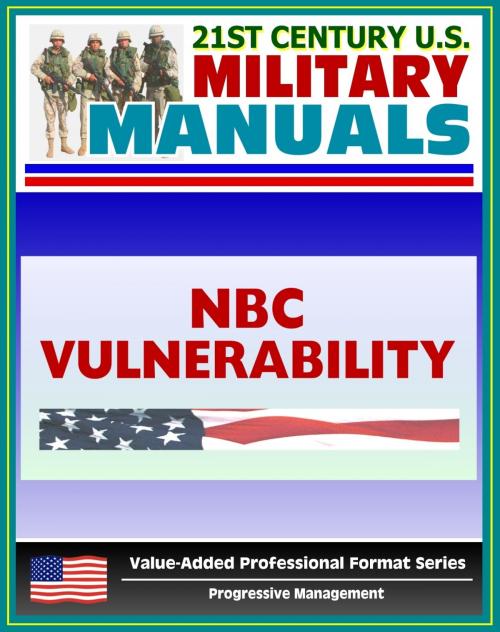21st Century U.S. Military Manuals: Nuclear, Biological, and Chemical (NBC) Vulnerability Analysis - FM 3-14 (Value-Added Professional Format Series)
Nonfiction, Science & Nature, Technology, Military Science, Social & Cultural Studies, Political Science| Author: | Progressive Management | ISBN: | 9781466057623 |
| Publisher: | Progressive Management | Publication: | September 11, 2011 |
| Imprint: | Smashwords Edition | Language: | English |
| Author: | Progressive Management |
| ISBN: | 9781466057623 |
| Publisher: | Progressive Management |
| Publication: | September 11, 2011 |
| Imprint: | Smashwords Edition |
| Language: | English |
Part of our value-added professional format series, the Nuclear, Biological, and Chemical (NBC) Vulnerability Analysis Field Manual (FM 3-14) deals with NBC weapons of mass destruction. This FM has been converted for accurate flowing-text e-book format reproduction.
In the preface, it states: "Enemy forces, terrorists, or warring factions may employ a variety of nuclear, biological and chemical (NBC) weapons in future conflicts, terrorism, or stability and support operations (SASO). The possible combinations of agents and delivery systems place military and civilians at risk at almost anytime or anyplace. Most nations can develop offensive NBC warfare capabilities through the restructuring of legitimate nuclear, medical, biotechnology, and chemical facilities. Additionally, the sale of technology and loss of control over weapons of mass destruction (WMD) increase the risk of employment against the US and its allies. Potential enemy nations or terrorist groups may believe these weapons provide a decisive advantage or psychological benefit against US forces and their allies. The manual’s purpose is twofold: a) aid chemical staff officers in conducting NBC vulnerability analyses and risk assessments during all phases of hostilities (pre-, conflict, and post-) and b) assist in advising commanders on force protection measures. Background information is provided for clarity or a baseline for understanding the chapter’s focal points. Chapter 1 addresses the intelligence preparation of the battlefield (IPB) and the chemical staff’s role within the process. Chapter 2 details friendly vulnerability analyses for enemy nuclear, biological and chemical weapons employment including low-level radiation, depleted uranium, and toxic industrial chemical concerns. Chapter 3 outlines vulnerability reduction measures the chemical staff can advise the commander to implement for force protection. The Appendices provide checklist formats for conducting risk assessments and possible employment indicators. Tables are included for information pertinent to vulnerability analyses."
This manual is produced by the U.S. Army Chemical School.
As a bonus, this reproduction includes FM-1, The Army Field Manual, a capstone manual containing the vision for the Army - sold separately for $5.99. FM 1 establishes the fundamental principles for employing Landpower. The most important of these are the Army's operational concept and the fundamentals that support it. They form the foundation for all Army doctrine. All Soldiers should understand and internalize them. FM 1 describes the American profession of arms, the Army's place in it, and what it means to be a professional Soldier.
This is a privately authored news service and educational publication of Progressive Management.
Part of our value-added professional format series, the Nuclear, Biological, and Chemical (NBC) Vulnerability Analysis Field Manual (FM 3-14) deals with NBC weapons of mass destruction. This FM has been converted for accurate flowing-text e-book format reproduction.
In the preface, it states: "Enemy forces, terrorists, or warring factions may employ a variety of nuclear, biological and chemical (NBC) weapons in future conflicts, terrorism, or stability and support operations (SASO). The possible combinations of agents and delivery systems place military and civilians at risk at almost anytime or anyplace. Most nations can develop offensive NBC warfare capabilities through the restructuring of legitimate nuclear, medical, biotechnology, and chemical facilities. Additionally, the sale of technology and loss of control over weapons of mass destruction (WMD) increase the risk of employment against the US and its allies. Potential enemy nations or terrorist groups may believe these weapons provide a decisive advantage or psychological benefit against US forces and their allies. The manual’s purpose is twofold: a) aid chemical staff officers in conducting NBC vulnerability analyses and risk assessments during all phases of hostilities (pre-, conflict, and post-) and b) assist in advising commanders on force protection measures. Background information is provided for clarity or a baseline for understanding the chapter’s focal points. Chapter 1 addresses the intelligence preparation of the battlefield (IPB) and the chemical staff’s role within the process. Chapter 2 details friendly vulnerability analyses for enemy nuclear, biological and chemical weapons employment including low-level radiation, depleted uranium, and toxic industrial chemical concerns. Chapter 3 outlines vulnerability reduction measures the chemical staff can advise the commander to implement for force protection. The Appendices provide checklist formats for conducting risk assessments and possible employment indicators. Tables are included for information pertinent to vulnerability analyses."
This manual is produced by the U.S. Army Chemical School.
As a bonus, this reproduction includes FM-1, The Army Field Manual, a capstone manual containing the vision for the Army - sold separately for $5.99. FM 1 establishes the fundamental principles for employing Landpower. The most important of these are the Army's operational concept and the fundamentals that support it. They form the foundation for all Army doctrine. All Soldiers should understand and internalize them. FM 1 describes the American profession of arms, the Army's place in it, and what it means to be a professional Soldier.
This is a privately authored news service and educational publication of Progressive Management.















